Metal and water are not the best of friends. At the hands of moisture, corrosion can occur, causing the metal to discolour and even lose its quality. Not such a rosy story, then… As a company, do you often ship metal products? If so, be sure to stop at proper corrosion protection. The best step-by-step approach is shown below.
1. What is corrosion? And why is corrosion protection so important?
‘Corrosion’ is an umbrella word for any kind of chemical deterioration of materials. This deterioration always has a negative effect on the quality of that material. For example, your material will:
- become weaker;
- decrease in volume;
- discolouring.
A specific form of corrosion is ‘rust’. This occurs when iron (steel) is affected by oxygen and water. As a result, the iron will start to oxidise and turn a brownish-red colour. Corrosion can also occur in copper (which will turn green), aluminium (which will take on a whitish hue) or silver (which will turn black in contact with sulphur). Corrosion protection ensures that the quality of your products is maintained. Therefore, you absolutely must not overlook this!
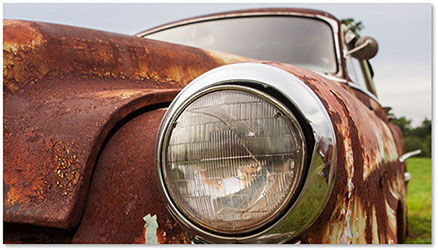
2. Where does corrosion come from?
Corrosion occurs when a metal is exposed to oxygen and water. So moisture formation is something we definitely want to avoid. In two situations in particular, you need to pay extra attention to corrosion protection:
► Overseas transport
When you ship products over water, there is of course a very good chance that they will come into contact with moisture. This can be through contact with seawater, but also due to maritime weather conditions. The longer your products are in transit, the greater the chance of corrosion.
If your products are transported by container, the high humidity inside that container will be a significant risk factor. Experts therefore recommend using materials with a moisture content below 15% and providing your products with quality corrosion protection.1
► Autumn and winter
Some seasons are already more ‘corrosion-friendly’ than others. Autumn and winter are often the wettest. Rain and snow are ideal partners in crime to create rust. A specific example of this is white rust.
White rust occurs on hot-dip galvanised steel that has come into contact with moisture during transport or storage and that has been poorly ventilated on top of that. At some point, the moisture will start to condense, causing white spots to appear on the steel. Although this does not affect the quality of the product, white rust does damage its appearance.2
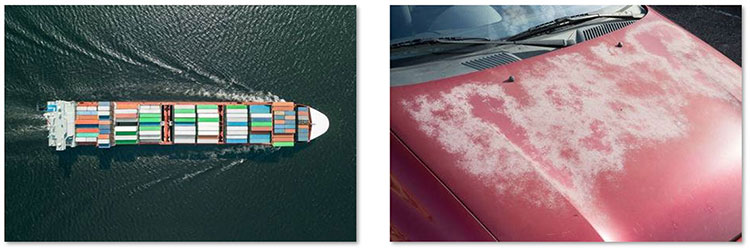
3. How to prevent corrosion?
]For corrosion, more than ever, prevention is better than cure. Everything starts with smart storage and thoughtful transport. Good VCI packaging forms the basis of our story. In addition, you can still use paraffin/bitumen paper and sachets of desiccant.
► VCI packaging
VCI is the abbreviation for ‘Volatile Corrosion Inhibitor’. It works as follows: in an enclosed space (such as a box), the VCI material creates an invisible shield on metal surfaces. The VCI shield does not change the properties of the metal. Instead, this shield blocks the ability of oxygen and moisture to attack metals. Once they arrive at their destination, you can use these metal parts immediately. No more cleaning or degreasing is needed.3
You will find some examples of popular VCI packaging below. By the way, a case in point is VCI-coated paper. It is usually more economical than plastic variants and is used in the automotive and metal industries, among others.
Plastic grip bag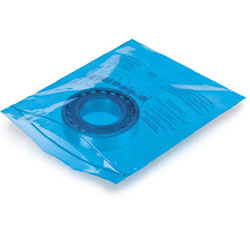 |
Plastic bag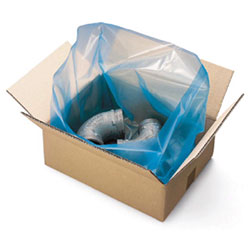 |
Plastic film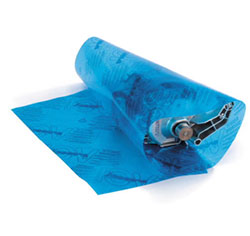 |
| For small products | For medium products | For large products |
| Polyethylene, 100 micron | Polyethylene, 100 micron | Polyethylene, 150 micron |
| With snap closure = Quickly closed |
With side folds = extra volume |
On a roll |
- VCI in 1940 was designed by George Daubert, owner of a petrol station? He mixed rust inhibitor with oils to create a fast-acting, environmentally friendly alternative to traditional greases and oils.
- VCI was first used en masse by the US army in 1940? The US used it during WWII when shipping weapons, machine parts, etc
► Paper with paraffin or bitumen
Besides VCI packaging, there are a few other waterproof solutions. For example, you have paper reinforced with an inner layer of bitumen. That paper is used in marine packaging, among other things. This protection can serve as a liner for cardboard and wooden export cases, overpacks and waterproof packing material.
Another example is paper with an outer layer of paraffin. This greasy layer ensures that water cannot penetrate the paper and therefore cannot affect your product.

► Desiccant
Want to really play it safe? Then combine your VCI packaging with a bag of desiccant. The desiccant absorbs moisture and thus reduces the risks of corrosion formation. For the most complete corrosion protection, you really can’t do without it.
Read more: Keep your shipping dry with silica gel dry bags ]4. How to use VCI packaging?
With VCI packaging, it is best to keep the following rules of thumb in mind. This is the only way to ensure optimal performance.
- Make sure your metal parts are clean and dry. Also let them acclimatise to the ambient temperature first (temperature shocks can cause condensation).
- No incipient corrosion should be present on your product.
- Wear gloves when using VCI packaging.
- There should be no direct contact between your metal parts and a corrosion-promoting material (e.g. wood or cardboard).
- Apply the VCI packaging with the printed side on the outside.
- Seal the packaging completely (best hermetically). This is the only way to guarantee its operation.
- Before unpacking, allow the metal parts to acclimatise to the ambient temperature. This again prevents condensation.
- After unpacking, your metal parts are immediately ready for use. The VCI protection leaves no further marks.
Sources:
1 www.praxas.com/nl-nl/Nieuws/Over-Praxas/ID/72/Corrosie-staal-tijdens-transport-en-opslag-hoeft-geen-uitdaging-meer-te-zijn
2 www.rotocoat.nl/verzinken/technische-informatie/witte-roest
3 www.cortecvci.com/how-vci-works/















